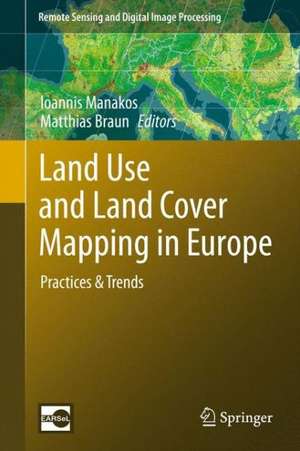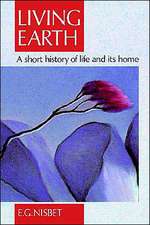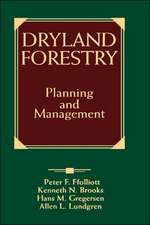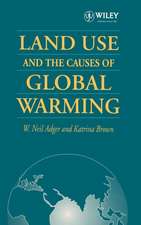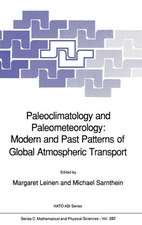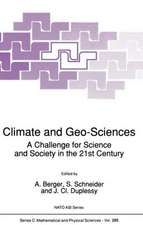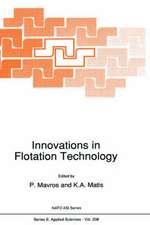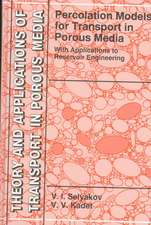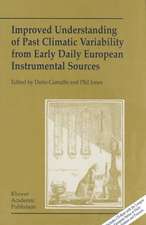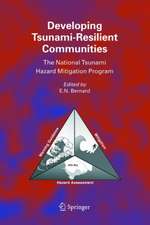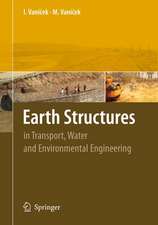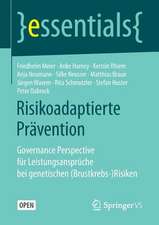Land Use and Land Cover Mapping in Europe: Practices & Trends: Remote Sensing and Digital Image Processing, cartea 18
Editat de Ioannis Manakos, Matthias Braunen Limba Engleză Hardback – 18 mar 2014
| Toate formatele și edițiile | Preț | Express |
|---|---|---|
| Paperback (1) | 574.12 lei 38-44 zile | |
| SPRINGER NETHERLANDS – 3 sep 2016 | 574.12 lei 38-44 zile | |
| Hardback (1) | 662.95 lei 6-8 săpt. | |
| SPRINGER NETHERLANDS – 18 mar 2014 | 662.95 lei 6-8 săpt. |
Din seria Remote Sensing and Digital Image Processing
- 18%
 Preț: 1020.74 lei
Preț: 1020.74 lei - 18%
 Preț: 1231.47 lei
Preț: 1231.47 lei - 18%
 Preț: 944.82 lei
Preț: 944.82 lei - 15%
 Preț: 530.42 lei
Preț: 530.42 lei - 24%
 Preț: 1613.55 lei
Preț: 1613.55 lei - 18%
 Preț: 1385.19 lei
Preț: 1385.19 lei - 24%
 Preț: 793.36 lei
Preț: 793.36 lei - 15%
 Preț: 640.37 lei
Preț: 640.37 lei - 18%
 Preț: 1112.15 lei
Preț: 1112.15 lei - 18%
 Preț: 1408.08 lei
Preț: 1408.08 lei - 18%
 Preț: 954.45 lei
Preț: 954.45 lei - 18%
 Preț: 1389.78 lei
Preț: 1389.78 lei - 24%
 Preț: 1476.62 lei
Preț: 1476.62 lei - 18%
 Preț: 1122.10 lei
Preț: 1122.10 lei - 18%
 Preț: 1407.64 lei
Preț: 1407.64 lei - 20%
 Preț: 988.27 lei
Preț: 988.27 lei - 18%
 Preț: 945.76 lei
Preț: 945.76 lei - 24%
 Preț: 802.74 lei
Preț: 802.74 lei - 15%
 Preț: 650.86 lei
Preț: 650.86 lei - 15%
 Preț: 650.37 lei
Preț: 650.37 lei - 15%
 Preț: 642.51 lei
Preț: 642.51 lei - 15%
 Preț: 653.46 lei
Preț: 653.46 lei
Preț: 662.95 lei
Preț vechi: 779.94 lei
-15% Nou
Puncte Express: 994
Preț estimativ în valută:
126.86€ • 132.78$ • 105.58£
126.86€ • 132.78$ • 105.58£
Carte tipărită la comandă
Livrare economică 31 martie-14 aprilie
Preluare comenzi: 021 569.72.76
Specificații
ISBN-13: 9789400779686
ISBN-10: 9400779682
Pagini: 456
Ilustrații: XI, 441 p. 112 illus., 79 illus. in color.
Dimensiuni: 155 x 235 x 30 mm
Greutate: 1.04 kg
Ediția:2014
Editura: SPRINGER NETHERLANDS
Colecția Springer
Seria Remote Sensing and Digital Image Processing
Locul publicării:Dordrecht, Netherlands
ISBN-10: 9400779682
Pagini: 456
Ilustrații: XI, 441 p. 112 illus., 79 illus. in color.
Dimensiuni: 155 x 235 x 30 mm
Greutate: 1.04 kg
Ediția:2014
Editura: SPRINGER NETHERLANDS
Colecția Springer
Seria Remote Sensing and Digital Image Processing
Locul publicării:Dordrecht, Netherlands
Public țintă
ResearchCuprins
Remote Sensing in support of the geo-information in Europe.- Global land cover mapping: Current status and future trends.- The users’ role in the current European land monitoring context.- Towards an European land cover monitoring service and high-resolution layers .- CORINE Land Cover and land cover change products.- European Area Frame Sampling based on Very High Resolution image.- European forest monitoring approaches.- The European Urban Atlas.- A review of modern approaches to classification of remote sensing data.- Recent advances in remote sensing change detection – a review.- Synergies from SAR-optical data fusion for LULC mapping.- Application of object-oriented method for classification of VHR satellite images using rule-based approach and texture measures.- Remote sensing of vegetation for nature conservation.- Modeling urban sprawl.- Land Information System Austria (LISA).- Digital Land Cover Model for Germany DLM DE – The “German Way”.- Land Use & land cover mapping in Europe: Examples from the UK.- Operational land cover and land use mapping in the Netherlands.- The use of the Land-Cover Classification System in Eastern European countries: experiences, lessons learnt and the way forward.- Differentiation of Crop Types and Grassland by Multi-Scale Analysis of Seasonal Satellite Data.- Enhancing remotely sensed low resolution vegetation data for assessing Mediterranean areas prone to land degradation.- Beyond NDVI: Extraction of biophysical variables from remote sensing imagery.- Land transformation processes in NE China: Tracking trade-offs in ecosystem services across several decades with Landsat-TM/ETM+ time series.- Carbon stock estimation of tropical forests on Borneo, Indonesia, for REDD+.
Notă biografică
Dr. Ioannis Manakos is a Researcher in ‘Remote Sensing’ at the Information Technologies Institute, Centre for Research and Technology Hellas, an Adjunct Professor at the International Centre for Advanced Mediterranean Agronomic Studies, where he headed the Department of the Geoinformation in Environmental Management for 7 years, cooperates with the Group on Earth Observations for the Global Land Cover Task, and is currently serving as the Chairman of the European Association of Remote Sensing Laboratories. During his studies he specialized in spectroradiometric measurements and reflectance modeling (PhD at the Technical University of Munich), and satellite image and geospatial data analysis (MSc and Diploma at the Aristotle University of Thessaloniki) for applications related with Agriculture, Environment and Physical Geography. He has been coordinating or participating in numerous EU, bilateral, and national projects (FPs, INTERREGs, etc.) for more than a decade. Activity topics concerned Global Monitoring for Environment and Security (GMES), Space and Airborne Remote Sensing and its Complementation and Synergy with in-situ measurements, Environmental Resources Management, Soil Erosion Risk Assessment, Agricultural Practice Monitoring, Precision Agriculture, Regional and Rural Development, Management of Mediterranean Ecosystems, Biodiversity, and Tourism. Numerous articles and studies of his have been published in Journals, Books, and Workshops.
Matthias Braun has studied at the University of Freiburg (PhD) and the University of Bonn. He is Chairman of the EARSeL special interest group on remote sensing of land use and land cover, as well as scientific Co-editor of EARSeL eProceedings. He is currently Associate Professor at the Geophysical Institute, University of Alaska Fairbanks.
Matthias Braun has studied at the University of Freiburg (PhD) and the University of Bonn. He is Chairman of the EARSeL special interest group on remote sensing of land use and land cover, as well as scientific Co-editor of EARSeL eProceedings. He is currently Associate Professor at the Geophysical Institute, University of Alaska Fairbanks.
Textul de pe ultima copertă
Land use and land cover (LULC) as well as its changes (LUCC) are an interplay between bio-geophysical characteristics of the landscape and climate as well as the complex human interaction including its different patterns of utilization superimposed on the natural vegetation. LULC is a core information layer for a variety of scientific and administrative tasks (e.g. hydrological modelling, climate models, land use planning). In particular in the context of climate change with its impacts on socio-economic, socio-ecologic systems as well as ecosystem services precise information on LULC and LUCC are mandatory baseline datasets required over large areas. Remote sensing can provide such information on different levels of detail and in a homogeneous and reliable way. Hence, LULC mapping can be regarded as a prototype for integrated approaches based on spaceborne and airborne remote sensing techniques combined with field observations. The book provides for the first time a comprehensive view of various LULC activities focusing on European initiatives, such as the LUCAS surveys, the CORINE land covers, the ESA/EU GMES program and its resulting Fast-Track- and Downstream Services, the EU JRC Global Land Cover, the ESA GlobCover project as well as the ESA initiative on Essential Climate Variables. All have and are producing highly appreciated land cover products. The book will cover the operational approaches, but also review current state-of-the-art scientific methodologies and recommendations for this field. It opens the view with best-practice examples that lead to a view that exceeds pure mapping, but to investigate into drivers and causes as well as future projections.
Caracteristici
Land use/land cover (LULC) information in its various forms and products is used as input by numerous users (e.g. modelers, planners, agricultural researchers, etc.), hence a very wide range of users and target groups should have considerable interest in having such a compilation The book will give for the first time a comprehensive overview on LULC activities in and from Europe (not only a single project outcome) from operational practice, best practice examples to current state-of the-art developments in methodology Many of these attempted concise descriptions are difficult to find otherwise The book also targets to bridge between science and application in this specific field Includes supplementary material: sn.pub/extras
